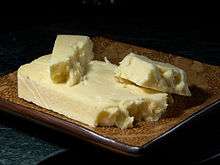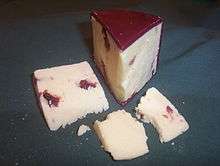Wensleydale cheese
| Wensleydale | |
|---|---|
 | |
| Country of origin | England |
| Region, town |
Wensleydale North Yorkshire |
| Source of milk | Cows (formerly ewes) |
| Pasteurised | Yes or no |
| Texture | Medium, crumbly |
| Aging time | 3–6 months |
| Certification | PGI (Yorkshire Wensleydale) [1] |
|
| |
Wensleydale is a style of cheese originally produced in Wensleydale, North Yorkshire, England, but now mostly made in large commercial creameries throughout the UK.
Flavour and texture
Good Wensleydale has a supple, crumbly, moist texture and resembles a young Caerphilly. The flavour suggests wild honey balanced with fresh acidity.[2][3]
History
Wensleydale cheese was first made by French Cistercian monks from the Roquefort region, who had settled in Wensleydale. They built a monastery at Fors, but some years later the monks moved to Jervaulx in Lower Wensleydale. They brought with them a recipe for making cheese from sheep's milk.[4] During the 14th century cows' milk began to be used instead, and the character of the cheese began to change. A little ewes' milk was still mixed in since it gave a more open texture, and allowed the development of the blue mould. At that time, Wensleydale was almost always blue with the white variety almost unknown. Nowadays, the opposite is true, with blue Wensleydale rarely seen. When the monastery was dissolved in 1540 the local farmers continued making the cheese right up until the Second World War, during which most milk in the country was used for the making of "Government Cheddar".[5] Even after rationing ceased in 1954, cheese making did not return to pre-war levels.[6]
Wensleydale Creamery

Wensleydale Creamery in the town of Hawes has been hand-making cheese for more than 100 years. In May 1992, Dairy Crest, a subsidiary of the Milk Marketing Board, closed the Hawes creamery with the loss of 59 jobs. This was the last creamery in the dale. Dairy Crest transferred production of Wensleydale cheese to Yorkshire's traditional rival, Lancashire. Six months later, in November 1992, following many rescue offers, a management buyout took place, led by local businessman John Gibson and the management team. With the help of eleven members of the former workforce, cheese making recommenced in Wensleydale.[7] It now (2012) employs 190 locals and buys from 36 farms located in Wensleydale.
The main types of cheese produced by the Wensleydale Creamery are:
- Real Yorkshire Wensleydale is usually shaped in a variety of weight moulds ranging in size from a small flat disc known as a "truckle" that is highly pressed and preserved in wax, to several larger cheeses—it is a mild cheese with an acidic, honeyed flavour
- Mature Wensleydale is a harder, more highly flavoured version of the Real Yorkshire Wensleydale
- Extra Mature Wensleydale the strongest Wensleydale cheese, matured for nine months
- Blue Wensleydale has blue veins and is produced in range of sizes. It is highly flavoured but less salty than the classic British blue Stilton
- Oak Smoked Wensleydale is cold smoked to produce a cheese with a special tang and texture. Cold smoking typically involves lower temperatures in the smoking process.
Wensleydale Dairy Products sought to protect the name Yorkshire Wensleydale under an EU regulation; PGI status was awarded in 2013.[1][8][9]
Common flavour combinations

The flavour of Wensleydale is suited to combination with sweeter produce, such as fruit. A popular combination available in many restaurants and delicatessens is Wensleydale containing cranberries.
In Yorkshire, apple pie may be accompanied by white Wensleydale, giving rise to the saying 'an apple pie without the cheese is like a kiss without the squeeze'.[10]
In Yorkshire and North East England it is often eaten with fruit cake or Christmas cake.
References in culture
In his essay "In Defence of English Cooking", George Orwell rates Wensleydale as second only to Stilton among British cheese varieties.
Wensleydale was one of the cheeses named by John Cleese in the Monty Python sketch "The Cheese Shop", which originally appeared in a 1972 episode of Monty Python's Flying Circus. In addition, the shop owner, played by Michael Palin, was named 'Henry Wensleydale', which caused some confusion between the two when the cheese was mentioned.
In the 1990s, sales of Wensleydale cheese had fallen so low that production was at risk of being suspended.[11] However, the popular Wallace and Gromit animated shorts A Grand Day Out and A Close Shave had the main character Wallace, a cheese connoisseur, mention Wensleydale as a particularly favourite cheese. Animator Nick Park chose it solely because it had a good name that would be interesting to animate rather than due to its origins in northern England where the shorts were set. He was also unaware of the financial difficulties that the company was experiencing.[12] The company contacted Aardman Animations about a licence for a special brand of "Wallace and Gromit Wensleydale", which proved to be an enormous success.[13] When the 2005 full-length Wallace and Gromit film, Curse of the Were-Rabbit, was released, sales of Wensleydale cheeses increased by 23%.[14][15]
See also
References
- 1 2 "Denomination Information Yorkshire Wensleydale". OJEU. Retrieved 18 May 2014.
- ↑ "Real Yorkshire Wensleydale". Wensleydale Creamery. Retrieved 3 July 2008.
- ↑ "Wensleydale Cheese". Lawsons Cheeses Direct. Archived from the original on 13 May 2008. Retrieved 3 July 2008.
- ↑ Rance, Patrick (1982). The Great British Cheese Book. Macmillan.
- ↑ "Government Cheddar Cheese". CooksInfo.com. Retrieved 17 July 2014.
- ↑ "History of Wensleydale Cheese". Wensleydale Creamery. Retrieved 3 July 2008.
- ↑ McAteer, Owen (30 July 2008). "Cheese firm wins overseas contracts worth millions". The Northern Echo. Retrieved 20 November 2012.
- ↑ "Uniquely Yorkshire". Yorkshire Post. Archived from the original on 3 January 2011. Retrieved 31 July 2008.
- ↑ "EU Application for Yorkshire Wensleydale". Retrieved 16 April 2009.
- ↑ "The Big Apple: "An apple pie without the cheese is like a kiss without the squeeze"". Barry Popik. Retrieved 16 July 2014.
- ↑ "Wensleydale is big cheese in world awards". Yorkshire Post. Retrieved 31 July 2008.
- ↑ "A Grand Day Out with Wallace and Gromit (1989)". uk.imdb.com. Retrieved 31 July 2008.
- ↑ "WallaceAndGromit.net". www.wallaceandgromit.net. Retrieved 31 July 2008.
- ↑ Reardanz, Karen (15 November 2005). "Wallace & Gromit Boost Cheese Sales". Hearst Communications Inc. Retrieved 3 July 2008.
- ↑ Reardanz, Karen (15 November 2005). "SFGate: Daily Dish : Wallace and Gromit Boost Cheese Sales". www.sfgate.com. Retrieved 31 July 2008.
External links
| Wikimedia Commons has media related to Wensleydale cheese. |